A practical guide to select the SMART digital Key Performance Indicators to grow your business in 2025 using VQVC
KPIs are a useful way for digital marketers to set expectations and prove that their work is having a positive impact. To outsiders, the success of digital marketing activity can be seen as difficult to measure but this really isn’t the case. In fact, it’s normally easier to measure progress metrics for a digital campaign than an offline one.
The aim of this post is to help you set digital marketing KPIs to measure what really matters at the moment, in a way that all parties can agree on. Smart marketing planning is essential for measuring and tracking your progress, and demonstrating value. We’ll cover negotiating KPIs, budgeting, and how to tie your KPIs into the Smart Insights RACE Digital Marketing Framework.
What are digital marketing KPIs?
Digital Marketing KPIs or Key Performance Indicators are quantifiable goals that help you to track and measure success. In a changing marketing landscape, such as today in the era of digital disruption, it's more important ever to plan your short-term and long-term KPIs that you select for digital marketing dashboards. See, for example, the recommended KPIs in the Smart Insights RACE digital marketing dashboard which we built for members using the latest version of the free tools Looker Studio and Google Analytics 4.
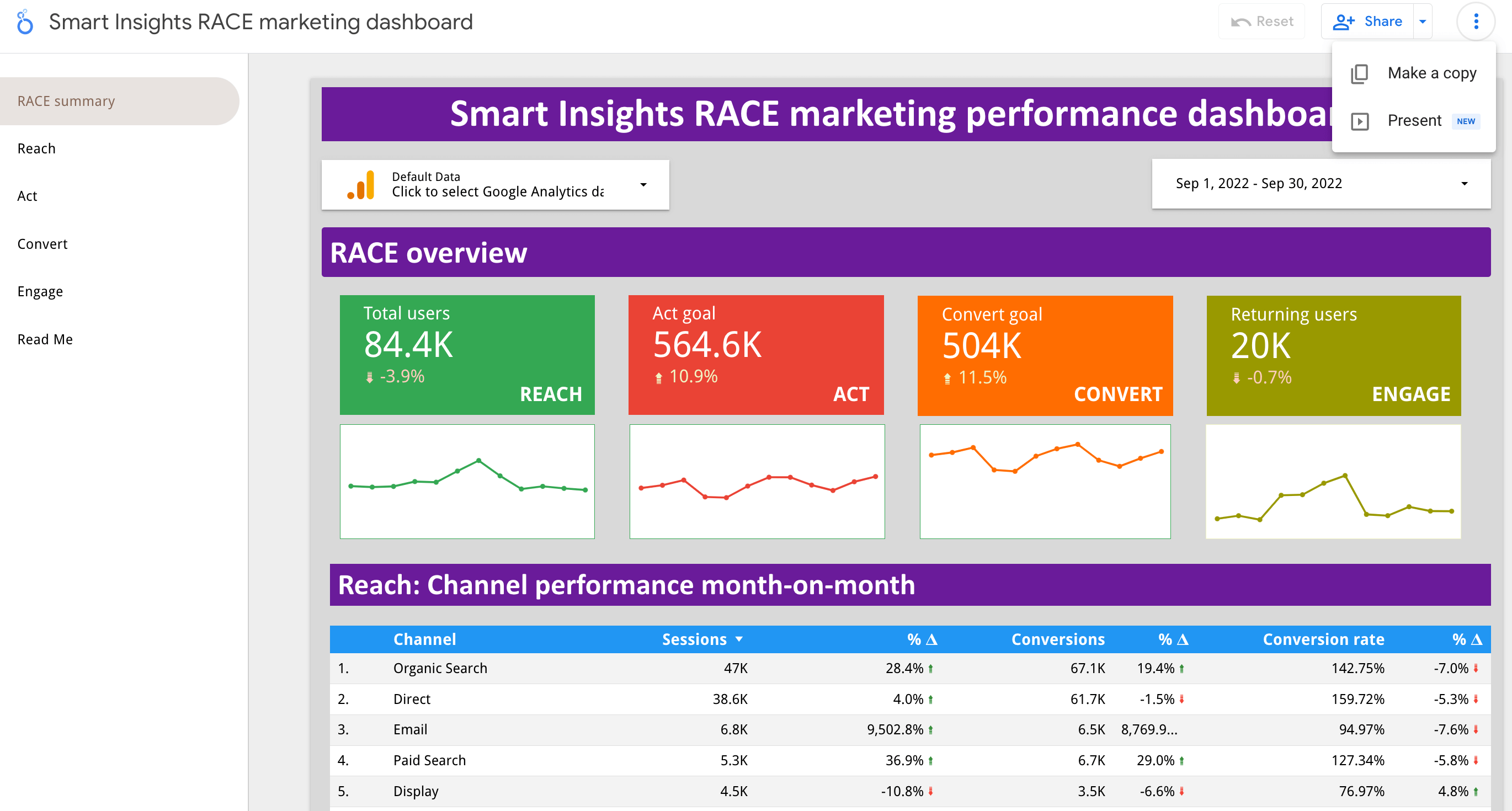
Using the correct digital marketing objectives in 2025
When selecting digital marketing objectives and KPIs to measure them, it's useful to have a framework to think through whether they are improving your marketing Dave Chaffey created VQVC to help with this many people focus on vanity metrics such as volume when considering visits or social media followers for example, but it's the quality and value measures that really matter and which we will cover in this post.
The best way to get started is to include VQVC measures for each channel, VQVC is:
- Volume: Number or % share of site visits
- Quality: Dwell time or conversion rate to lead or sale
- Value: Revenue per visit (Ecommerce) or Goal value per visit (if goals set up for non-Ecommerce site)
- Cost: Cost per visit/lead/sale
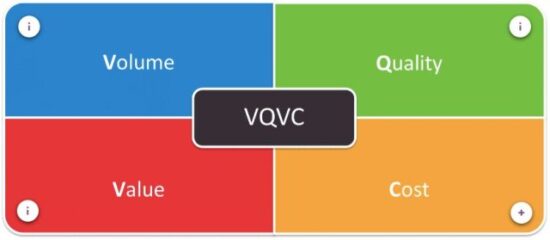
It takes time to accurately pull together these figures, but if you don't know the figures how can you improve? VQVC can be very helpful for comparing digital media activities, or for channel benchmarking against competitors, for example, those with similar media budget spend.
To review your current use of measurement and analytics in your business to improve results from your digital marketing we recommend you download our benchmark templates:
Free digital marketing maturity benchmarking templates
Quickly review and improve your digital marketing maturity across platforms with our free benchmarking templates.
Access the Digital marketing maturity audit templates
Setting digital marketing KPIs
The most important part of setting a digital marketing KPI is choosing what to measure. You really don’t want to go wrong at this stage but don’t worry, it’s pretty simple – just make sure you measure factors that will have an impact on your organization’s targets or goals.
You need to select both Effectiveness KPIs that help show the overall contribution that digital marketing is making to your business and Efficiency KPIs that help review how well your marketing funnel is working. See Dave Chaffey's articles for examples of the difference between Effectiveness and efficiency KPIs for digital marketing and How to set SMART marketing objectives - the need for SMART marketing objectives applies equally to digital marketing metrics.
Often KPIs are connected to a “conversion” metric. In today's competitive landscape, conversions are more important than ever. As a general rule, conversions should be specific (i.e. easily to define and measure) and significantly beneficial (E.G. a user filling in a contact form on making a purchase). You will set targets and goals for each conversion type, so it's vital to focus on the added value to the company with each conversion event.
Which metrics should you measure in digital marketing?
- Quantifiable metrics which align with the goals of your organization. These will often be sales or leads. If you work for a startup it might be too soon to measure leads but you can always measure reach and engagement.
- Leading Indicators. A leading indicator is used by economists to give an indication of which way the economy is headed. A leading indicator is important for reporting because it can show that your time and effort are starting to have an impact even if it hasn’t yet had significant results. For example, you might measure how many people have spent over 3 minutes on your site even if they haven’t filled in the contact form.
Which metrics should you not measure in digital marketing?
- Things you can’t impact. If you can’t change it, there’s no point in it being a KPI.
- Vanity metrics. The classic example of a vanity metric is a Managing Director who wants to be at the top of Google for a keyword that doesn’t provide any traffic which converts.
Use our useful infographic to determine which digital marketing metrics to track:
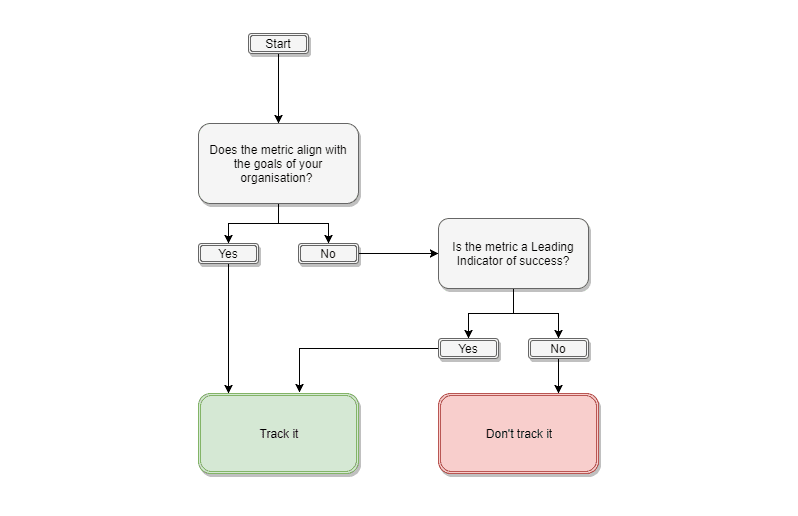
How to set channel-specific KPIs
Some KPIs should be channel-specific and others will relate to overall business goals. Many organizations will need KPIs of both types in order to measure both channel performance and the impact this then has on overall goals.
In larger organizations, different individuals or teams will run individual channels so each should be measured separately. In a smaller team, or this will be divided up in a way that works for your marketing mix. If you're looking for more inspiration on goal setting, find out more about how and why marketing goals can help you achieve success and how and why they need to be aligned with your digital marketing objectives.
NB some parts of your marketing mix may need more attention than others, so it's worth planning your priorities in this case, and attributing appropriate resources.
6 channel-specific KPIs - e-commerce example
The chart below shows examples of KPIs and Leading Indicators for 6 typical digital marketing channels:
- Social - Conversions
- SEO - Revenue
- PPC - CPA
- Email - CR%
- Referrals - Revenue
- Content - Conversions
I have based these on an E-commerce client so they mainly focus on conversions and revenue.
However, it's important to note that digital marketing channels don’t all have the same primary KPI. This is because, in this example, not all channels are likely to have a direct impact on revenue/conversions.
For example, it might be unrealistic to expect social media to have a direct impact on revenue depending on your offering. Therefore the primary KPI for social media might be 'reach'.

In the above example, the primary KPI for PPC is cost per acquisition rather than revenue as revenue would only give us part of the picture. Any big changes in PPC budget would have a significant impact on revenue but this wouldn’t be an indication that the PPC activity is going well necessarily. It’s better to measure cost per acquisition as this takes budget changes out of the calculation.
Tying budgets to digital marketing KPIs
This one is all about prioritizing. I recently attended a workshop called How to Build your Digital Strategy presented by a consultant from Indus Net Techshu, a very successful Digital Marketing agency from India. Amongst many interesting ideas one, in particular, stood out:
“You can fix your KPIs or you can fix your budget. They can’t both be fixed.”
The idea of KPIs being so heavily dependent on a budget is particularly relevant for PPC Campaigns. Often clients or bosses will have an idea about what KPIs they want to achieve along with what budget they want to spend before doing any research or talking to an expert. This is no good as the KPI has essentially just been plucked from the ether.
An example:
Your boss asks for 20 conversions with a spend of £500 but your target keywords cost £5 a click and the site has a 4% conversion rate.
500 [£spend] ÷ 5 [£CPC] = 100 [visits] x 0.04 [4% conversion rate] = 4 [conversions]
In this situation, you would set a KPI of around 4 conversions for this spend and then explain what you can do to bring the cost-per-click down and the conversion rate up. You might set a slightly more ambitious KPI based on your experience and how you’ve been able to optimize previous campaigns.
You could also ask your boss if they would be willing to increase the spend to £2,500 in order to bring in 20 conversions they originally asked for. Linking the activity back to your SMART objectives will help you demonstrate the need for continued investment in digital marketing to drive results.
KPIs, and goals in general, need to be clearly understood by everyone involved. It’s very easy for different people to have different interpretations of a goal even when it seems as unambiguous as a quantified KPI. Therefore all KPIs should be SMART:
- Specific
- Measurable
- Achievable
- Relevant
- Time-Bound
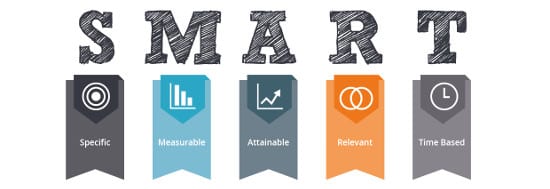
These 5 factors are pretty self-explanatory (and covered in more detail in Dave Chaffey's article: How to define SMART marketing objectives) so I won’t explain each part. The key thing to understand is that you should never assume that the other party sees the KPIs the same way you do.
As an example “I need you to double conversions” could mean different things to different people. “I need you to achieve a 100% increase in qualified conversions YoY by the end of quarter 4” is a lot less open to interpretation. Ensuring your KPIs are SMART will save you a lot of bother down the line.
How to negotiate your digital marketing KPIs
Setting and agreeing upon KPIs can sometimes require some negotiation skills. Like most negotiating you’ll need to learn how to hold your nerve. It can be easy to agree to a figure you don’t think you’ll be able to achieve in order to end an awkward conversation and move on but this isn’t the best course of action.
If you can argue your corner it’ll pay off, for everyone, in the long run. Having to explain why you didn’t meet a KPI (and why it was not realistic in the first place) isn’t much fun. You’re better off being able to say “we hit that KPI so let's now set a new one”.
The person you’re negotiating with may push you on the KPI so you will need to be prepared. In Roger Fisher and William L. Ury’s book 'Getting to Yes: Negotiating Agreement Without Giving In' they suggest that adding in a new factor can help to break a deadlock in negotiations. Rather than both parties trying to move a single figure either up or down, you can introduce a new element that you both might be more inclined to adjust.
In this case, you might ask for more budget or more man-hours in order to hit the original KPI they asked for. Or you might suggest lowering a different KPI so that you can put more time and resource on this one.
How to set KPI Boundaries
SMART KPIs are a great way of detailing exactly what needs to be achieved but they can be hit or miss as you either deliver on them or you don’t. A 98% increase in conversions when you’ve agreed to a 100% increase could be seen as either “near enough” or a complete failure depending on how reasonable you are. A good KPI prevents this from being an issue by having all parties agreeing on what is acceptable upfront.
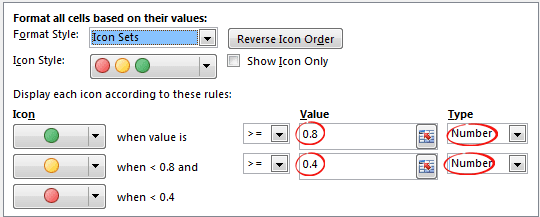
A traffic light system can be used in Excel to measure KPI performance using boundaries
Not long after I first became an SEO Account Manager in my first agency I was given a new client who had agreed to KPIs with the salesperson who closed the sale. The salesperson was receiving a commission and therefore was happy to agree to double organic traffic to 6 geographic subfolders of the international site in 6 different languages within 6 months of the campaign starting. This was not a realistic KPI particularly considering that one of the sections of the site was in Russian. I found it quite difficult to optimize the site in Russian and didn’t really have time to learn a new alphabet.
Somehow, I achieved two-thirds of the impossible and managed to increase traffic for 4 out of 6 subfolders within 6 months. I was very pleased with myself but the client had promised their boss the impossible so as far as she was concerned I had failed completely.
Aligning KPIs to the RACE model
Chances are you’ll already be familiar with the RACE Framework which splits the customer journey into 4 main stages with recommended KPIs defined for each.
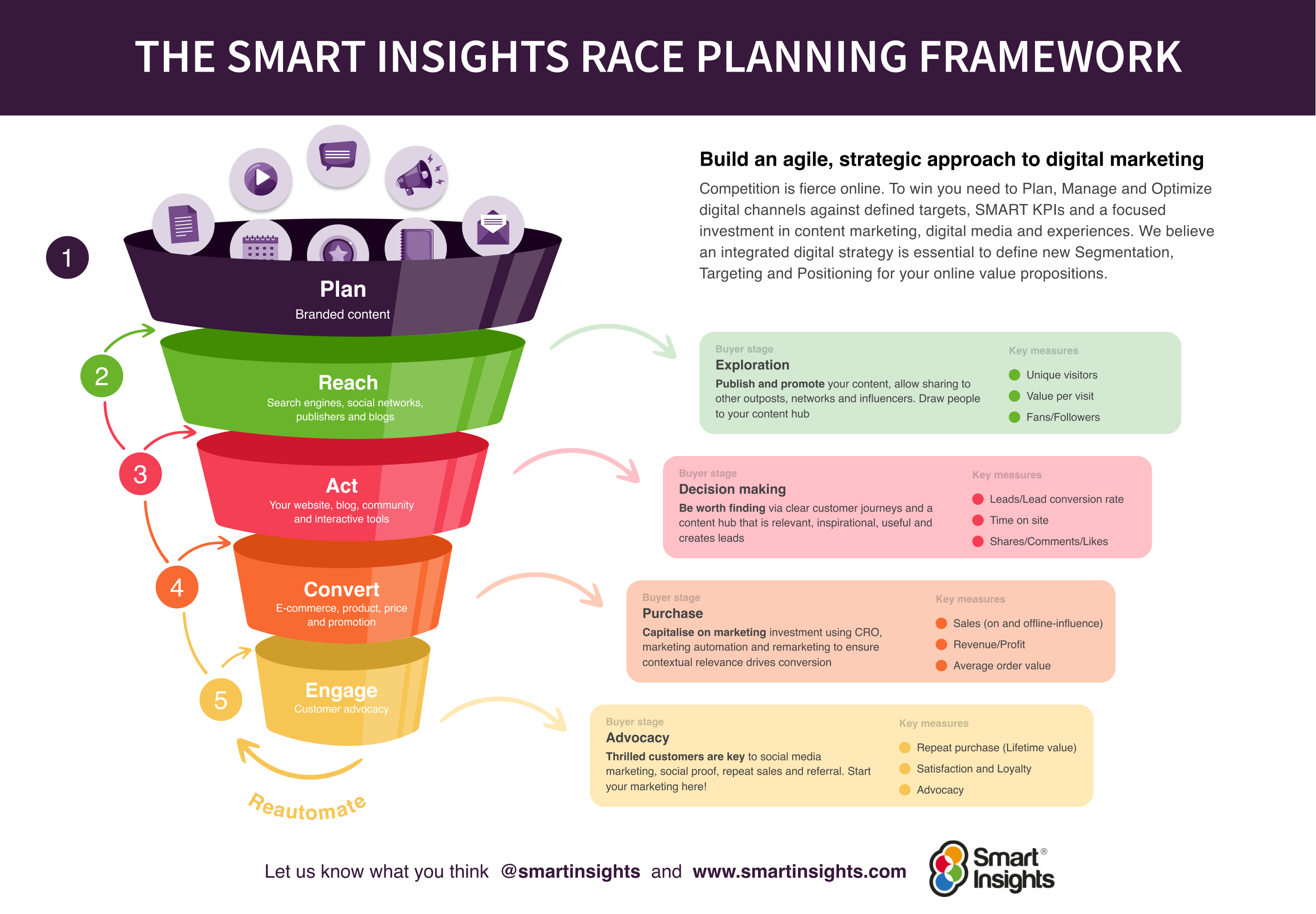
If this framework is something you use, you can match your KPIs to different stages of the process, for example:

This method is great as it allows you to easily measure KPIs all the way through the funnel rather than just focusing on conversions. Aligning your KPI tracking to your particular marketing approach will help to ensure you’re tracking what matters rather than just what is easiest to measure.
Our popular step-by-step RACE Growth System guides marketers and their teams to plan, manage, and optimize each stage of the customer journey within their purchase funnels. Integrated across reach, act, convert, and engage, our lifecycle tool helps you accelerate key metrics to grow your business.
Measuring your digital marketing KPIs
Using the SMART model all your digital marketing KPIs will be time-bound so you’ll know what you need to achieve and by when. You will also be able to see how well you are progressing before the KPI is actually due. If you don’t think you will be able to hit your KPI it’s important to update the other party on a regular basis so that they don’t encounter any nasty surprises. It is particularly important to keep track of your progress during a recession as market fluctuations could have a much bigger impact on your financials.
If you aren’t on track and it’s not your fault you should flag this up as soon as possible. For example, if you’re working on an SEO campaign and the developers haven’t implemented any of your recommended changes (not that this ever happens) you need to explain why this is an issue and explain what the impact will be:
“I understand that you’ve not been able to find the resource to implement the changes and this is understandable given how much needs to be done. Because of this, I think we should re-calculate the KPIs to take this into account.”
You have to do this before the KPI is due. You can’t turn up to a meeting with excuses (even if they’re reasonable) if you haven’t already flagged the issue.
Conclusion
As you can see there is a lot to consider when setting your digital marketing KPIs during a recession but spending the time planning up-front is worth the investment. Being able to choose suitable KPIs is a key skill for digital marketers and one which takes some practice to perfect. You won’t get it right every time but taking the time to predict what you can achieve and then measure your performance will help you to grow as a marketer.














